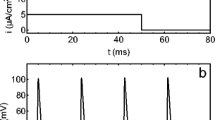Abstract
We study two different two-dimensional reductions of the Hodgkin-Huxley equations. We show that they display the same qualitative bifurcation scheme as the original equations but overestimate the current range where periodic emission occurs. This is essentially due to the assumption that the evolution of the sodium activation variable m is instantaneous with respect to the dynamics of the variables h and n, an hypothesis that breaks down at high values of the injected current. To prove this point we compare the current-amplitude relation, the current-frequency relation, and the shapes of individual spikes for the two reduced models to the results obtained for the original Hodgkin-Huxley model and for a three dimensional model with instantaneous sodium activation. We show that a more satisfying agreement with the original Hodgkin-Huxley equations is obtained if we modify the evolution equation for the potential by incorporating the prominent features of the dynamics of m.
Similar content being viewed by others
References
Hodgkin AL, Huxley AF (1952) J Physiol 117:500
Tuckwell HC (1988) Introduction to theoretical neurobiology. Cambridge University Press, Cambridge
Cronin J (1987) Mathematical aspects of Hodgkin-Huxley neural theory. Cambridge University Press, Cambridge
Rogawski MA (1985) TINS 214–219
Connor JA, Stevens CF (1971) J Physiol 213:1
Connor JA, Walker D, McKown R (1977) J Biophys 18:81
Hassard BD (1978) J Theoret Biol 71:401
Hassard BD (1981) Theory and applications of the Hopf bifurcation, Cambridge University Press, Cambridge
Troy WC (1978) Q Appl Math 73–83
Hopf E, (1942) Berh Verh Sachs Akad Wiss Leipzig Math-Nat 94:3
Mardsen JE, McCracken M (1976) The Hopf bifurcation and its applications. Appl Math Sci, Springer, Berlin Heidelberg New York, 19
Rinzel J, Ermentrout GB (1989) Analysis of neural excitability and oscillations. In: Koch C, Segev I (eds) Methods of neuronal modeling. MIT Press, Cambridge
Hansel D, Mako G, Memiev C (1992) Phase dynamics for weakly coupled Hodgkin-Huxley neurons, submitted to Physical Review Letters
Fitzhugh R (1961) J Biophys 1:445
Nagumo J, Arimoto S, Yoshizawa S (1962) Proc JRE 50:2061
Troy WC (1976) J Mathe Anal Appl 54:678
Kokoz YM, Krinskii VI (1973) Biofizika 18(5):878
Krinskii VI, Kokoz YM (1973) Biofizika 18(3):506
Kepler TB (1990) Mathematical reduction of complex neural models, proceedings of the Second STG Conference, Waltham, USA
Abott LF, Kepler TB (1989) Model neurons: from HodgkinHuxley to Hopfield, Proceedings of the XI Sitges Conference, Sitges, Spain
Morris C, Lecar H (1981) J Biophys 35:193
Jahnsen H, Llinas R (1984) J Physiol 349:227
Plant RE, Kim M (1976) J Biophys 16:227
Epstein IR, Marder E (1990) Biol Cybern 63:25
Author information
Authors and Affiliations
Rights and permissions
About this article
Cite this article
Meunier, C. Two and three dimensional reductions of the Hodgkin-Huxley system: separation of time scales and bifurcation schemes. Biol. Cybern. 67, 461–468 (1992). https://doi.org/10.1007/BF00200990
Received:
Accepted:
Issue Date:
DOI: https://doi.org/10.1007/BF00200990




